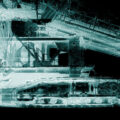The Mastery of Absences: China Miéville’s This Census-Taker

If texts with narrative plots and wholesome structures are read and written according to disciplines and procedures conforming to their configurations, then perforated structures, degenerate formations, and plot holes must have reading and writing methodologies of their own.
—Reza Negarestani, Cyclonopedia
An Incomplete History of the Plot Hole
Call it the intentional lacuna: a place where the narrative demands a description, but none appears. This can be distinguished easily from archival gaps, missing manuscripts, lost volumes. It’s the void of the form, as important as its body. This perhaps initially arose as a means of expressing the divine Mystery. Consider Semele, incinerated by her glimpse of Zeus, and King Polydectes who was turned into stone when he saw the face of the Gorgon; or the God of Israel, who said to Moses, “you cannot see my face, for no one may see me and live.”
As long as faith persisted, the encounter with the divine would end in a gap in the narrative—a missing description which stands for the unseeable, the altogether-too-much. In his last days, Thomas Aquinas remarks, “I can write no more. I have seen things that make my writings like straw.” Six decades later, Dante reaches a similar formulation at the very climax of The Divine Comedy:
From this time onward greater was my sight
than is our speech, which yields to such a vision,
and memory also yields to such excess.And such as he, who seeth in a dream,
and after it, the imprinted feeling stays,
while all the rest returns not to his mind;
even such am I; for almost wholly fades
my vision…
One hundred cantos are completed in the Mystery of an ellipsis.
In modernity the loss of the bedrock sense of the divine caused, at first, a reverse of the epiphanic quality of the lacuna. While it had once been a gesture toward the Mystery, it began to represent instead the maddening absence of God—first, in 1853, in Bartleby, the Scrivener:
“Why, how now? what next?” exclaimed I, “do no more writing?”
“No more.”
“And what is the reason?”
“Do you not see the reason for yourself,” he indifferently replied.
Kafka later takes up this theme, with his opaque procedures of an indecipherable law. The alienation of Bartleby and the remoteness of the Castle are both instances of modernity’s anguished attempt to pry open a godless universe.
These were not, by any means, the only uses made of the lacuna after the age of the divine. Other modern secularists began to focus on the lacuna itself as a matter of special interest; two great exemplars are Lovecraft and Proust.
Lovecraft takes a premodern approach, substituting the perverted Mystery of his monster-gods for the classical Mystery of the Greek, Jewish, and Christian gods. His appropriately-named 1923 story “The Unnamable” ends with a grotesque parody of Aquinas and Dante:
“Good God, Manton, but what was it? Those scars—was it like that?”
And I was too dazed to exult when he whispered back a thing I had half expected—
“No—it wasn’t that way at all. It was everywhere—a gelatin—a slime—yet it had shapes, a thousand shapes of horror beyond all memory. There were eyes—and a blemish. It was the pit—the maelstrom—the ultimate abomination. Carter, it was the unnamable!”
In contrast, Proust’s Marcel spends perhaps a thousand pages obsessing over whether Albertine was unfaithful. This too is unknowable; even confirmation of her infidelity becomes ambiguous, so that ultimately the lacuna descends from the heavens and assumes a more domestic role as an artifact of the epistemology of jealousy.
The intentional lacuna thus enters the contemporary period as a literary object of structural interest, quite apart from the content being obscured. Yet it tends to serve as well, through resonance or tradition, several narrative roles: on the one hand, it illustrates an intuition that human and methodological frailty limit knowledge even in a positivistic culture; and on the other, it refers not to the divine but to the absence of the divine, which, as in Lovecraft, may invert itself as the unspeakable.
China Miéville and the Lacuna
China Miéville’s writing has made use of the lacuna from the earliest published works. His Bas-Lag novels—written from 2000 to 2004, and set on Bas-Lag, a planet like ours except more detailed and filthy—include two major lacunae: a land area called the cacotopic Stain and a rift in the sea called the Scar. These are geographical lacunae. They’re regions where reality takes on such inconceivable characteristics that, beyond a few introductory details at their peripheries, they must remain unknown. As with victims of the Gorgon, those who enter these regions are transformed beyond the possibility of witness or survival.
The Stain and the Scar, however, appear in the context of a world overfull with wondrous images: soul-sucking moths, mutation as punishment for crime, a race of beetle-headed women, a ship-city towed by a gigantic amoeboid, and endlessly on.
The Bas-Lag novels were published when Miéville was quite young, and they mark the start of an extraordinarily successful career. For all that, he headlines his blog with a telling quotation from Georg Christoph Lichtenberg:
A principal rule for writers, and especially those who want to describe their own sensations, is not to believe that their doing so indicates they possess a special disposition of nature in this respect. Others can perhaps do it just as well as you can. Only they do not make a business of it, because it seems to them silly to publicize such things.
It seems obvious that this is a warning from Miéville, chiefly to himself, against the deadly vice of self-satisfaction. Early success can engender in writers a certain anxiety about the sources of that success: that is, about their talents. Talent is different from skill. Like beauty, one may be born with talent (Lichtenberg’s “special disposition of nature”). Skill, on the other hand, must be earned. The evolution of Miéville’s novels suggests a progressive mistrust of his own talents—foremost among them, the fertility of his imagination, offering one astonishing image after another. He seems to rebel against this talent, demanding of himself books built on skill.
This struggle plays out in the evolving role of the intentional lacuna. The Stain and the Scar are offhanded absences, background detail, deployed mainly for dramatic emphasis in the context of a bewilderingly crowded landscape. By the time he publishes The City and The City (2009), though, his attention turns more specifically to the lacunae. In this surreal crime novel, two cities occupy the same geographical space, existing in uneasy overlap through the fine subdivision of territory. The complexity of this subdivision opens the possibility that cartographic errors have left room for a third city, a city in the gaps. The lacuna here is identified with one of its frequent companions, the conspiracy. They are superficially similar: the information content of a conspiracy is concealed, while that of a lacuna is unknowable. For the time being, they appear the same because one does not know the important facts about either one.
The gradual solution of the crime involves the differentiation between the fantastical conspiracy of an entire hidden city, and the squalid, real-life conspiracy of criminal politicians and businessmen who murdered a young woman who became inconvenient. Thus the conspiracy comes loose from the lacuna; the conspiracy is broken up, but the question of the third city remains unresolved.
Miéville’s first overt psychological use of the lacuna occurs in Embassytown (2011), a novel in which an alien species requires humans to play out various dramatic scenarios in order to add these scenarios as concepts to the aliens’ language. The adult narrator, Avice, had the honor of playing a role in such a scenario when she was a girl. The aliens wished to add the concept:
There was a human girl who in pain ate what was given her in an old room built for eating in which eating had not happened for a time.
The narrator, Avice, describes her memory of the experience as follows:
What occurred in that crumbling once-dining room wasn’t by any means the worst thing I’ve ever suffered, or the most painful, or the most disgusting. It was quite bearable. It was, however, the least comprehensible event that had or has ever happened to me. I was surprised how much that upset me.
The concept, reduced to a girl ate what was given her, recurs throughout the book; but the details of the event are never supplied. The lacuna-as-trauma haunts the novel and animates Avice’s detachment. What might in a more trivial concealment register as mere euphemism takes on the stature of the lacuna when the key facts of the character are generally stated but specifically unspoken.
After 2011, an interesting phenomenon emerges. The lacuna expands, and to some extent, Miéville finds in it a replacement for the use of the image itself. Absences begin to operate in the way that fullness had before. Where the image may represent that talent with which the author cannot make peace, the lacuna represents a resolution, a challenge related to silence, as when Beckett abandoned the English language. It can only be conquered through practice–through skill. The brimming fullness of the Miévillian image and the haunting emptiness of the Miévillian lacuna ultimately serve much the same structural role in his work, and function as obverse and reverse of one another. If his images can be feared to have no back, then his absences in turn seethe with content.
Miéville’s short story collection Three Moments of an Explosion (2015) uses the lacuna in a variety of contexts: unnamed punishments, indescribable monsters, unreachable territories, unexplained phenomena. Response to this collection among his fans was mixed. This is not surprising, as Miéville is no longer the writer he was, and his writing in turn no longer offers the rewards that it once did. This evolution is remarkable, though, to be sure, not all of the lacunae in Three Moments of an Explosion really work. In the collection, Miéville appears to be exploring the technique. He deploys lacunae in a crazed variety of aspects, as if he were seeking a mode of the lacuna around which to build something more ambitious.
Eclipse

This Census-Taker
by China Miéville
Hardcover, $24.00
Penguin Random House, 2016
Let me begin my discussion of This Census-Taker (2016) by admitting that I love this book. For me, it stands in relation to all but the best of Miéville’s previous work as the thing itself stands in relation to a description of the thing; not like recounting a dream, but like dreaming it. It treats very little, and yet the things it treats, it plumbs to the marrow. It reveals something precious. In it, the grip of the author’s hand eases at last, so that he scarcely pushes the words; therefore it is a book of few words, stripped of excess until those words achieve a heartbreaking clarity. This book represents a breakthrough for Miéville.
(Extensive spoilers follow.)
This Census-Taker begins, “A boy ran down a hill path screaming. The boy was I.” The narrative is being told in recollection by the boy, now an adult. As a child, the boy lived with his distant father and stern mother in a rickety house on a semi-arid hill outside a small town. The hill and the town occupy a four-way world, depicted with elements of the age of electricity, the age of steam, the trappings of science fiction, and the trappings of fantasy, though no one element is emphasized or decisive. The opening scene ends:
I kept up the hands I thought were bloody for them to see.
I shouted, “My mother killed my father!”
This account rapidly disintegrates, so that who was present, and who killed whom—if in fact anyone was killed—becomes fatally unclear. The boy’s father is soon found, but his mother is missing. The father claims she walked out, but the boy settles on his father’s having killed her. Lacuna #1: lacuna of event.
If in fact the father killed her, where could he have hidden the body? Here the story moves farther into the past, to the boy’s account of his father compulsively beating animals to death and then taking them to a nearby cave, where he flings them into a functionally bottomless rift used as a trash pit. The boy becomes convinced his mother’s body lies at the bottom of this pit, irrecoverable. Lacuna #2: lacuna of geography.
The father himself, it emerges, suffers from the aftershocks of his early life in a distant land. “He came by boat: he had to leave his own place, which is a bigger city a long way off, because of trouble there.” The trouble is never specifically explained—there are mentions of “immense foreign wars,” and intimations of war in the science fiction facet of the book’s world. What the father saw, or did, is unstated. Lacuna #3: lacuna of history.
Finally, late in the book, this census-taker appears, on the boy’s doorstep, while his father is away. The census-taker is a native of the father’s city, and explains:
“What I do is I count people. I count people and things.
“Not everyone. If you counted everyone you’d never stop, would you? I’m putting things in sets. My job’s to count just the people who were born where I was, or whose parents or grandparents were. Then I write down what I’ve counted. That’s my job. I started years ago, when we decided we had to take stock of things. After troubles. We needed to know where we were. Where we all were.”
Consider the lilting menace in those last two sentences, gliding smoothly from “where we were,” an idiom of status check, to “where we all were,” a phrase of hunting-down-our-own. The creepily chipper stranger listens to the boy’s tale, and spelunks to the bottom of the trash pit—though what he sees there, he does not say. He afterward encounters the boy’s father as well, though what the stranger does to him, the boy does not see.
Is the father a murderer? Is the stranger an innocuous eccentric? A government functionary? Or a roving executioner, completing a genocide? Lacuna #4: lacuna of motive.
Other significant omissions speckle the narrative. But perhaps the most vivid is the image of a favorite iron fence in town (a detail evocative of Proust):
There, a tree had once grown up and through the fence, sealing itself around the bars until it had provoked the unfriendliness of the owner and been cut down, leaving that part of itself that couldn’t be extricated. That part I would finger at the join of bark and iron when I walked through where the tree had been.
Here the book offers a key to the unsettling eclipse of its narrative. The boy’s own intuitive sense of these gaps, and his response to them, is captured in the sketch of the fence and the tree. He notes the absence, and relishes its boundaries with that primal sense, touch, as he occupies the space freed up and still defined by the missing object. The anecdote captures the intensity and sense of magic in childhood, and the process of organic completion that comes naturally to children’s minds.
The missing pieces in his story are organically missing and are of are two basic types. The first is what adults refuse to tell children and they cannot find out for themselves. The second is what children do not think to ask, because they don’t have an adult’s understanding of people and the world. From the perspective of adulthood, the book’s chain of logic is painfully deformed; yet from the perspective of the boy narrator, the gaps seem rather infrequent. His world is full of effects for which he does not instinctively seek causes. Effects without causes are called miracles. The book shimmers with miracles, as childhood does.
Once the reader’s need for clarity and resolution in the surface narrative is overcome, the book’s true virtue moves to the fore: a portrait of childhood, as experienced in overwhelming present tense. This picture has its own evolution, a structure based on theme instead of story. It starts with, and frequently returns to, the intensity and specificity of sensation itself—here the narrator describes the top floor of his home, a single empty room:
I liked to climb the steep stairs to play alone in that wind-filled room. All the rest of the house was whitewashed or painted in an ocher made from local earth, but two walls of the attic were papered in a repeating design. The tangled flowers and pagodas astonished me. I couldn’t imagine my mother or my father choosing them. I decided the paper must have predated my parents’ arrival, which made me contemplate the house before they came to it, the house empty of them. That made me queasy and excited.
The description also presents the numinous sense that children have, how they spontaneously create secret meanings, entire worlds known only to themselves and to the living quality of their places.
The portrait of a child’s perspective proceeds from place to parents, the narrator’s harsh, eccentric mother, and his father, so frighteningly withdrawn and capable of violence:
My father passed me. He looked briefly at me as you might at a stump or a broken machine or anything that’s specific only in that it’s in your way, to walk around it as my father did me.
It extends from home to town, to the dismal town as playground for the boy, with its beggars and bottled lizards, its starfish glimpsed in murky tanks, and bridge and bats, and shabby roads and commerce, all of them wondrous to the child, and most especially the gang of street children his mother nudges him into companionship with:
I got caught up in the gang’s quick dramas, so thoroughly that when at last I saw my mother at the street’s end below spitting streetlights, I realized she’d been waiting in the shadows for a while. She was standing with her eyes closed, listening to the bulbs’ buzz, leaving it to me to see her.
I was crying at that moment, at some brutal turn of the children’s game, and they were muttering to me with solicitous scorn.
When they shouted at me they called me uphiller. I didn’t call them anything.
Once this expanding portrait of childhood is complete, the book proceeds to bounce the trauma of the possible murder off of it. Sent home by the baffled police to live alone with his father, boy and man find themselves beyond reconciliation. The father expresses a wounded and consuming love for his son, and in return the son tries to escape, finding refuge with his gang of street children, under the protection of their teenaged leaders, Drobe and Samma:
“Your mum’s in heaven now,” Drobe said.
I looked down at the cobbles. He said it to be kind.
Something sublime lies in these awkward, gruff, Truffaut-like interactions. He is so utterly helpless to evade his own suffering. Every lurch away from it draws him toward it. But even in his pain, the intensity of perception bends everything toward beauty. He remains intoxicated with his world, as awful as it proves to be. His escape into the independent society of children forms the emotional core of the book, and it is self-evident that these few hours of amity, in the midst of a rolling, formless nightmare, could come in hindsight to define a life.
The third act of this sorrowful tale concerns the census-taker. It is here that the book turns to one of the chief terrors of childhood: the inability to distinguish good from evil.
The census-taker exhibits every sign of evil. He carries a peculiar gun native to the father’s city, which makes a sound that previously echoed in the hills, which the father has described as coming from “the kind of shot you use to kill a man.” The census-taker has no good explanation for what he is doing. When challenged, he asserts, “I do have this authority. To make this count.” He pretty clearly murders the boy’s father, although, although–we do not see it. The boy closes his eyes; there are only suggestive sounds. Even if it happened, though, had the father been a war criminal? If the boy’s description of his cruel, mechanical killing reflects anything, then the census-taker may represent the reach of justice. Unlikely, but possible. The gentle and endlessly shifty census-taker is terrifyingly ambiguous.
With the boy’s remaining parent gone, the census-taker takes him on as an intern, effectively adopting him—a turn of events so odd, and seemingly arbitrary, that it begs for more explanation than is ever offered. The boy is raised to perform a set of tasks that remain unclear, and he arrives at adulthood with this chilling quality: that he recounts his childhood without remarking on the lacunae. What is captivating in a boy, however, becomes subtly horrific in a man: that he has never sought to resolve the gaps in his understanding. That he allows the census-taker to remain suspended in the overlap of good and evil, a moral position the narrator now occupies as well. Ultimately, This Census-Taker takes on the nostalgia of the corrupt for their innocence.
In the most creative of writing, a puzzle is set up which is resolved not as the sum of the established set of parts, but rather through an unexpected image which both resolves the puzzle and introduces a revelatory new element–something which could never have been anticipated. In a sense, Miéville performs such a lateral synthesis with This Census-Taker. It addresses the original lacuna of the divine Mystery, and the harrowing lacuna of the modern loss of God; it addresses the lacuna as psychological phenomenon, and as mechanism of structural interest. It does all these things in an utterly unexpected way: by fusing these elements naturally into the perspective of a boy as recalled by a broken man. The boy is moved by a child’s almost religious sense of wonder and by a child’s terror at the loss of his parents. The book presents lacunae both as lapses in the cognition of a child and as defense mechanisms in the psychopathology of a man. The dense tapestry of overlapping absences dextrously meets the challenge of lacuna as structural peculiarity.
This is not, however, a book devoted to cleverness. It is not a book of many things, but of one thing expressed in many ways. Plunged in an unnavigable murk, innocence shines through the book—alert, vibrant, vulnerable, filled with a capacity for joy that cannot but go on being rewarded even by a world of woe. Miéville has uncovered a thing stubborn and precious. No writerly pirouette could take him to this uncorrupted, overwhelming aggregate of misery and joy. Without the devouring lacunae, this story would be categorically diminished. Miéville has achieved an instance of the retrieval of lost time. In this case, it is the most essential of lost time, that age between the onset of reason and the start of puberty, a time which holds in it a happiness we dare not hope to live again this side of old age—except, perhaps, in books.
About Daniel Maidman
Daniel Maidman is an artist and writer. His art and writing on art have been featured in ARTnews, Forbes, Juxtapoz, Hyperallergic, American Art Collector, International Artist, Poets/Artists, MAKE, Manifest, and The Artist’s Magazine. He blogs for The Huffington Post. His drawings and paintings are included in the permanent collections of the Library of Congress, the New Britain Museum of American Art, and the Long Beach Museum of Art. He lives and works in Brooklyn, New York.





